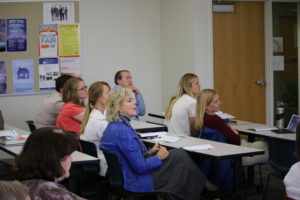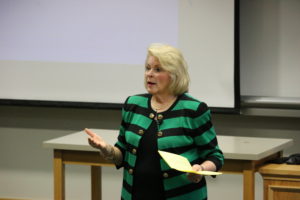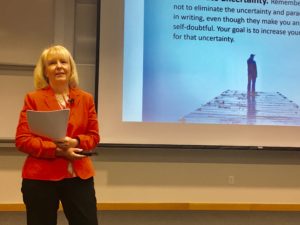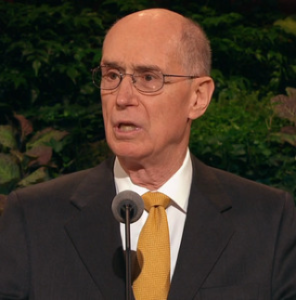By James Beers, Symposium Creator
To be honest, the genesis of Utah’s 2018 Book Marketing Symposium was a selfish one—I (yes, emphasis on the I) wanted to and needed to know more about book marketing. But marketing sessions at writing conferences were often in short supply. With few exceptions, the writing conferences, workshops, and seminars I have attended in previous years focused almost exclusively on writing craft, a vitally important subject but not the only aspect of writing necessary to make an author successful. At first, I didn’t think much of it, but two observations soon brought to the forefront the fact that book marketing needed more attention.
First, I noticed that I was hearing the same information again and again during each writing event I attended. At least 90% of the information was focused on writing craft. Second, I had already crossed the first major hurdle in a writing career: I had written and published. In my case, it was a short story, a novelette, and a book. But none of them were selling very well, just a few copies here and there. I thought perhaps it was the quality of my writing that needed improvement. So I joined writing groups, received writing critiques, entered contests, and practiced writing. My stories won contests, so I knew I was at least on the right track with my writing craft. But my published works still weren’t selling any better. No matter how many Facebook friends I garnered, how many blog and social media posts I put up, or how many freebie promos I offered, book sales would not increase. There was something about marketing that I was missing, and I was bound and determined to figure it out.
That’s where the idea for Utah’s 2018 Book Marketing Symposium started. I thought maybe I could get a bunch of successful book marketers together to teach me and other authors something about book marketing. I knew I likely couldn’t pull it off by myself, so I sat down with several other writerly folks and said, “Hey, what do you think about organizing a book marketing event?” They responded, “Yeah, let’s do it!” And so we did. Although one book marketing event wouldn’t be a magic bullet, it was at least a start.
It’s one thing to come up with an idea and entirely another thing to bring it to life. There were a ton of items to consider to make the book marketing event happen: venue, presenters, volunteers, advertising, food and catering, scheduling, money, resources, and on and on and on. That doesn’t even include the underlying questions: will it really work and will people actually pay to attend it?
Eventually, five writing organizations—the League of Utah Writers (LUW); the Latter-day Saint Publishing and Media Association (LDSPMA); and the Utah chapters of the Society of Children’s Book Writers and Illustrators (SCBWI), the Horror Writers Association (UHWA), and the Romance Writers of America (URWA)—came together to help me breathe life into the idea. LUW obtained a venue that wouldn’t financially kill us to rent or require that we charge several hundred dollars for each registration. LDSPMA posted the event on its website and social media accounts, put out notices in its newsletter, and even helped me find several volunteers among its members to help at the event. SCBWI also advertised the event in its member newsletter. UHWA passed out flyers for us at LTUE. And URWA (as well as the other organizations) served as a sounding board for ideas and helped me come up with the name for the event: Utah’s 2018 Book Marketing Symposium. The name wasn’t super catchy, but it embodied the idea that Utah, which has a large writing community, needed a book marketing event.
The biggest challenges occurred where the rubber met the road. Concepts like finding a place for the event, needing presenters, offering vendor tables, and having a printed program were discussed easily enough, but securing help to actually make them happen was very difficult. Also, no one was willing to take the financial risk to head up the event. These were huge obstacles. I eventually had to buckle down and do it largely by myself. I formed and funded an organization to sponsor the event. I also designed ads and the printed program layout, set up registration on Eventbrite, and procured all the presenters. When it came down to overcoming these challenges, I didn’t have a lot of money to hire help, nor a lot of time to waste trying to convince others to sacrifice and help. So I put my head down, went to work, and made it happen by shear will and elbow grease.
I can’t tell you how many prayers I said, asking for help to make the symposium successful. Fortunately, a long time ago the Lord taught me through a few bad choices on my part to never procrastinate. Thus, I started early enough that there were never really any hectic, anxiety-filled moments at the end in which I wondered if I would get everything together in time. The book-cover contest came close to giving me a coronary, but in retrospect, even the challenges with the contest weren’t too bad.
I could tell during the event planning when the Lord was feeding me ideas; they just popped into my head, made sense, and were brilliant. For instance, I was prompted to make a simple feedback form that attendees could turn in for a code to be included in a raffle for books and gift certificates donated by authors, bookstores, and editing services. The feedback raffle idea worked very well and gave us some great feedback for next year. I was also prompted to organize a tally system and associated prize raffle to encourage people to visit vendor tables. Each of the vendors had a different colored marker for marking a tally box in the back of people’s programs. After all the vendors marked the tally boxes, the conference attendee showed the page to a volunteer at the registration desk and received a code for another raffle. The tally system was hugely successful, and many of the vendors said they appreciated the traffic it brought to their tables.
Over 100 people, including registrants, vendors, and volunteers, came to the symposium. Although my brain was AWOL on the day of the event, the symposium went off without any major hitches, due in large part to a handful of excellent volunteers: Anna King, Tara Creel, Kenny Smith, Jenna Beers, Bob Casey, Mark Hasara, and Jerald Simon.

The feedback was overwhelmingly positive. One of the attendees told me that he learned more from the symposium than he had from a recent three-day writing conference. Several attendees expressed that they’d like to see the symposium become an annual event. Here are just a few of the positive comments:
“This was a SMASHING success! I learned a ton!”
“The information from the presenters was amazing! The vendors were also very personable and answered all of my questions. I loved how intimate the symposium was. Everything was great! Thank you!”
“Very valuable! Well worth my time and money.”
Now that the conference is over, I’m constantly thinking about what worked well and brainstorming what we can improve and what new things we can do to make next year’s symposium even better. For instance, I’d like to hold a full-day symposium on a Saturday so even more people can attend. I’ll definitely use the feedback and vendor raffles, but with a few tweaks. I’ve also been thinking about hands-on workshops (building a Facebook sales funnel, creating effective ads on Amazon, and building newsletters, etc.). I also plan to improve registration, check-in, and the book-cover contest.
I learned a lot about organizing a symposium, as well as invaluable marketing strategies—which was the whole reason for the event. I know others also gained some great insights about marketing. One of the presenters—a well-known author and book marketer in her own right—said she attended the other classes and learned a lot about marketing.
I’m excited about the 2019 symposium and know it will be even better than the inaugural event.
Please enjoy photos from this year’s symposium:
For more information about the Utah’s Book Marketing Symposium, please visit their website at: https://www.ubmcon.com/




















 We kicked off the conference with a wonderful message from John S. Tanner, president of BYU–Hawaii. Speaking metaphorically, he compared Latter-day Saint publishing professionals to anableps, an unusual kind of fish with eyes on the top of its head that simultaneously see both below and above the water. “In a similar fashion,” he said, “Latter-day Saint publishing professionals must look up to heaven and down to earth at the same time. They must care about mundane matters, like markets, profits, and the expectations of audiences, yet they need to do so with eyes single to God and His glory.” This practical and inspiring message was the perfect start to our conference.
We kicked off the conference with a wonderful message from John S. Tanner, president of BYU–Hawaii. Speaking metaphorically, he compared Latter-day Saint publishing professionals to anableps, an unusual kind of fish with eyes on the top of its head that simultaneously see both below and above the water. “In a similar fashion,” he said, “Latter-day Saint publishing professionals must look up to heaven and down to earth at the same time. They must care about mundane matters, like markets, profits, and the expectations of audiences, yet they need to do so with eyes single to God and His glory.” This practical and inspiring message was the perfect start to our conference.





 We closed the first day of our conference with an inspiring message from Sheri Dew. Drawing upon the phenomenon of the Total Eclipse in August, Sister Dew talked about how every human being has a divine orbit and the potential and privilege to influence all who come inside his or her orbit. “Those blessed with gifts of expression are in a unique position to have incalculable influence and do inestimable good,” she said. As one conference attendee put it, “Sheri Dew completely changed the way I think about myself as a writer. No longer do I desire to become famous just for the sake of being famous. Now, I desire only to build the Lord’s kingdom, and if as a result I become famous, well then, all the better for being an instrument in His hands. My work isn’t about me anymore. It’s about Him.”
We closed the first day of our conference with an inspiring message from Sheri Dew. Drawing upon the phenomenon of the Total Eclipse in August, Sister Dew talked about how every human being has a divine orbit and the potential and privilege to influence all who come inside his or her orbit. “Those blessed with gifts of expression are in a unique position to have incalculable influence and do inestimable good,” she said. As one conference attendee put it, “Sheri Dew completely changed the way I think about myself as a writer. No longer do I desire to become famous just for the sake of being famous. Now, I desire only to build the Lord’s kingdom, and if as a result I become famous, well then, all the better for being an instrument in His hands. My work isn’t about me anymore. It’s about Him.” The next morning, conference-attendees arrived eagerly anticipating what new wisdom the day had in store for them. Wendy Ulrich started off the day by instructing us on how to navigate the paradoxes of creating content for a Latter-day Saint audience. She said, “As authors and artists, we want to offer something fresh and new, but we’ll have trouble getting heard if we stray outside the bounds of Church orthodoxy. Secular training may increase our credibility with some Latter-day Saints but decrease it with others. Our personal faith experience gives us insight into our audience but can tempt us to overextrapolate. Navigating paradox is an element of artistic and psychological maturity that will enrich both our creations and our ability to publish and sell them.” Paradoxes indeed! We so appreciated Sister Ulrich’s guidance and expertise.
The next morning, conference-attendees arrived eagerly anticipating what new wisdom the day had in store for them. Wendy Ulrich started off the day by instructing us on how to navigate the paradoxes of creating content for a Latter-day Saint audience. She said, “As authors and artists, we want to offer something fresh and new, but we’ll have trouble getting heard if we stray outside the bounds of Church orthodoxy. Secular training may increase our credibility with some Latter-day Saints but decrease it with others. Our personal faith experience gives us insight into our audience but can tempt us to overextrapolate. Navigating paradox is an element of artistic and psychological maturity that will enrich both our creations and our ability to publish and sell them.” Paradoxes indeed! We so appreciated Sister Ulrich’s guidance and expertise.



